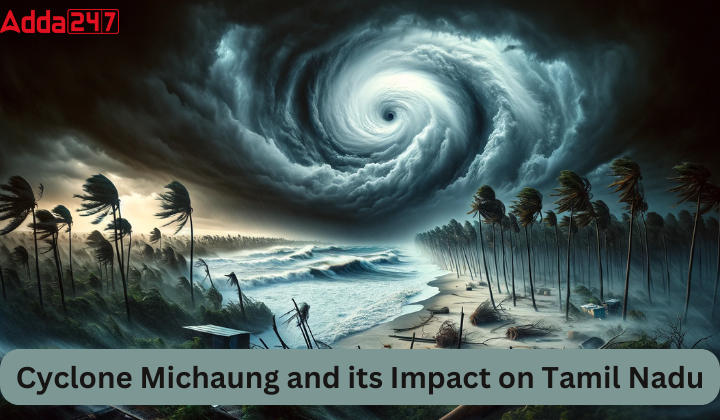Table of Contents
Cyclones, a formidable natural phenomenon, often wreak havoc with their violent storms and adverse weather conditions. The recent announcement by the Indian Meteorological Department (IMD) about Cyclone Michaung making landfall in Tamil Nadu has brought the spotlight back on these powerful weather systems. To comprehend the intricacies of cyclones, it’s essential to delve into the two broad categories defined by the National Disaster Management Authority (NDMA): extratropical cyclones and tropical cyclones.
What is a Cyclone?
A cyclone is a large-scale air mass that rotates around a central low-pressure area. Due to violent storms and unfavorable weather, cyclones—characterized by inward-spiraling winds—can cause significant damage.
The rotation of these winds is anticlockwise in the northern hemisphere and clockwise in the southern hemisphere.
Formation of Cyclones
Cyclones form due to variations in atmospheric conditions. Factors like sea surface temperature, humidity, wind patterns, and the Earth’s rotation contribute to their development. They typically gain strength over warm ocean waters, drawing energy from the heat and moisture of the environment.
Types of Cyclones
The National Disaster Management Authority (NDMA) classifies cyclones into two main types: extratropical and tropical cyclones.
Extratropical Cyclones
Extratropical cyclones, often known as mid-latitude cyclones, form outside tropical regions, beyond the Tropic of Cancer and the Tropic of Capricorn. Unlike their tropical counterparts, these cyclones have cold air at their core.
These cyclones possess cold air at their core and draw energy from the interaction between cold and warm air masses.
The U.S. National Oceanic and Atmospheric Administration (NOAA) explains that extratropical cyclones are invariably associated with one or more fronts, which delineate the boundaries between different air masses.
A front acts as a weather system where warm air confronts cold air. Extratropical cyclones can manifest over both land and ocean, impacting regions with their characteristic weather patterns. Understanding their dynamics aids in predicting and mitigating their impact.
Tropical Cyclones
Tropical cyclones, unlike their extratropical counterparts, originate in the regions between the Tropics of Capricorn and Cancer. These storms are renowned as the most destructive on Earth, unleashing intense winds and rainfall.
The NOAA sheds light on the development process of tropical cyclones, stating that they emerge when thunderstorm activity intensifies near the center of circulation.
Unlike extratropical cyclones, tropical cyclones derive their energy primarily from the release of latent heat. This heat is generated when water vapor evaporates from warm ocean waters and condenses into liquid water.
Warm and cold fronts are not associated with tropical cyclones, making them distinct in their formation and behavior.
Geographical Diversity of Tropical Cyclones
Tropical cyclones vary in nomenclature based on their location and strength. The Caribbean Sea, the Gulf of Mexico, the North Atlantic Ocean, and the eastern and central North Pacific Ocean are referred to as hurricanes.
In the western North Pacific, these formidable storms are known as typhoons. Understanding these geographical distinctions is crucial for effective communication and disaster preparedness.
Cyclone Michaung’s Impact on Tamil Nadu
The recent announcement of Cyclone Michaung making landfall in Tamil Nadu raises concerns about its potential impact on the region. Heavy rainfall has already been witnessed in parts of Tamil Nadu, including the capital city of Chennai and nearby districts.
Reports of power cuts and disruptions in transportation further highlight the challenges posed by cyclones.
The Indian Meteorological Department’s forecast serves as a timely reminder of the need for robust disaster management strategies and community preparedness.
To reduce the potential damage from the cyclonic storm, authorities in Tamil Nadu, Andhra Pradesh, and Odisha are on high alert.
Preparedness and Mitigation Strategies
In the face of an approaching cyclone, preparedness and mitigation strategies play a pivotal role in safeguarding lives and minimizing property damage.
Government agencies, along with local communities, need to collaborate on evacuation plans, emergency shelters, and communication systems to ensure a swift response to the impending disaster.
Public awareness campaigns, early warning systems, and coordination among various stakeholders contribute significantly to effective disaster management.
Lessons learned from past cyclones can inform better strategies, including infrastructure improvements, resilient urban planning, and efficient evacuation routes.
Climate Change and Cyclones
As the frequency and intensity of cyclones continue to capture global attention, the role of climate change in shaping these weather phenomena cannot be ignored.
Rising sea temperatures, changing atmospheric conditions, and alterations in ocean currents contribute to the evolving dynamics of cyclones.
Understanding the interconnected reality of climate change and cyclones is essential for formulating sustainable policies and practices. Mitigating the impact of cyclones requires a comprehensive approach that addresses both the immediate challenges posed by individual storms and the broader context of a changing climate.
Conclusion
In conclusion, the imminent arrival of Cyclone Michaung in Tamil Nadu serves as a stark reminder of the relentless force of nature. From the classification of cyclones into extratropical and tropical categories to the distinct characteristics of each, a comprehensive understanding is crucial for effective disaster preparedness.
As communities brace themselves for the impact of Cyclone Michaung, it is imperative to recognize the importance of proactive measures, community involvement, and global efforts to address climate change. Navigating the cyclone landscape requires a combination of scientific knowledge, technological advancements, and a collective commitment to building resilient societies capable of withstanding the challenges posed by these formidable weather systems.



 TSPSC Group 1 Question Paper 2024, Downl...
TSPSC Group 1 Question Paper 2024, Downl...
 TSPSC Group 1 Answer key 2024 Out, Downl...
TSPSC Group 1 Answer key 2024 Out, Downl...
 UPSC Prelims 2024 Question Paper, Downlo...
UPSC Prelims 2024 Question Paper, Downlo...
